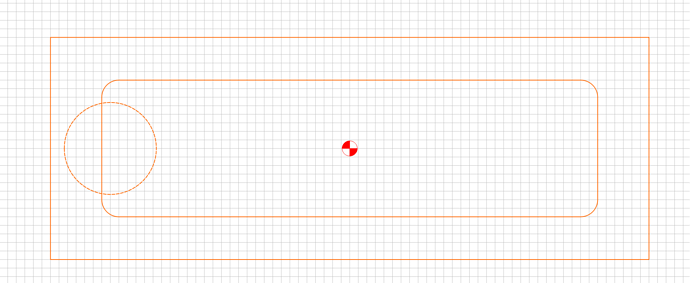OK…I can’t just let this drop. I started to experiment with the modeling and attempted to observe the behavior of the various parameters. I’ve begun to chart out those observations. This is, by no means, complete (and may even be inaccurate) and I would much rather have C3d developers post what’s really going on in the calculations, but here are my findings - so far. I cannot figure out what the real purpose of max and min are…and multiply SEEMS to have no purpose. I need to do more observations.
This is the design I worked with:
Component 1 is a flat base of 5" (Add 5" Flat) for the large square. I then started to apply different parameters to the fillet’d design component to make observations. Then, I started to apply different parameters to the circle to try to see how the parameters blended between components.
Here’s my current chart:
| Meaning of “Height” Parameter | ||||||||
|---|---|---|---|---|---|---|---|---|
| Shape | Height Limit | Add | Subtract | Min | Max | Multiply | Equal | |
| Flat | None | Amount Added | Amount Subtracted | Baseline of piece | Top of Piece | Undetermined | Resultant Height | |
| Limit | N/A | N/A | N/A | N/A | N/A | N/A | ||
| Scale | N/A | N/A | N/A | N/A | N/A | N/A | ||
| Round | None | No Bearing (Determined by Angle) Relative to previous height | No Bearing (Determined by Angle) Relative to previous height | Baseline of Piece (no Round) | Top of Piece (No Round) | Top of Piece (No Round) | No Bearing Round starts at bottom of piece | |
| Limit | Truncates round (Determined by Angle) at an additional height; relative to previous height | Truncates round (Determined by Angle) at an subtracted height; Relative to previous height | Baseline of Piece (no Round) | Height at Previous Height (No Round) | Top of Piece (No Round) | Truncates round (Determined by Angle) at an additional height; Starting at bottom of piece | ||
| Scale | Height of Peak relative to previous heights | Depth of the Peak. Relative to previous height | Peak starting at baseline Truncated to previous lowest height | Peak height starting at previous height | Top of Piece (No Round) | Resultant Height of Peak, Round starts at bottom | ||
| Angle | None | No Bearing (Determined by Angle) Relative to previous height | No Bearing (Determined by Angle) Relative to previous height | Baseline of Piece (no Round) | Top of Piece (No Round) | Top of Piece (No Round) | No Bearing Angle starts at bottom of piece | |
| Limit | Truncates angle (Determined by Angle) at an additional height; relative to previous height | Truncates round (Determined by Angle) at an subtracted height; Relative to previous height | Baseline of Piece (no Round) | Height at Previous Height (No Round) | Top of Piece (No Round) | Truncates round (Determined by Angle) at an additional height; Starting at bottom of piece | ||
| Scale | Height of Peak relative to previous heights | Depth of the Peak. Relative to previous height | Peak starting at baseline Truncated to previous lowest height | Peak height starting at previous height | Top of Piece (No Round) | Resultant Height of Peak, Angle starts at bottom |
I will try to keep this updated as I learn more…but I would LOVE for folks to chime in on their observations (or knowledge) with regard to these points.
